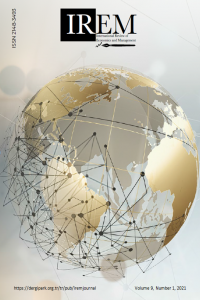TRADE RULES FOR UNCLEARED MARKETS WITH A VARIBLE POPULATION
We analyze markets in open economies in which the price of a traded commodity is fixed and as a result of this stickiness, the demand and the supply are possibly unequal. In our model, the agents have single peaked preferences on their consumption and production choices. For such markets, we analyze the implications of population changes as formalized by the well-known “consistency” property. We first characterize the subclass of “Uniform trade rules” that satisfies Pareto optimality, no-envy, and consistency. Next, we add an informational simplicity property which is called “independence of trade volume” and we show that among the “Uniform trade rules” that satisfy Pareto optimality, no-envy, and consistency, only the one that clear either the short or long side of the market satisfies independence of trade volume.
Anahtar Kelimeler:
market disequilibrium, trade rule, variable population, efficiency, consistency
TRADE RULES FOR UNCLEARED MARKETS WITH A VARIBLE POPULATION
We analyze markets in open economies in which the price of a traded commodity is fixed and as a result of this stickiness, the demand and the supply are possibly unequal. In our model, the agents have single peaked preferences on their consumption and production choices. For such markets, we analyze the implications of population changes as formalized by the well-known “consistency” property. We first characterize the subclass of “Uniform trade rules” that satisfies Pareto optimality, no-envy, and consistency. Next, we add an informational simplicity property which is called “independence of trade volume” and we show that among the “Uniform trade rules” that satisfy Pareto optimality, no-envy, and consistency, only the one that clear either the short or long side of the market satisfies independence of trade volume.
Keywords:
market disequilibrium, trade rule, variable population, efficiency, consistency,
___
- [1] Benassy, JP. (1993), “Nonclearing markets: microeconomic concepts and macroeconomic applications ", Journal of Economic Literature, 31, 732-761.
- [2] Ching, S. (1992), “A simple characterization of the Uniform rule", Economics Letters, 40, 57-60.
- [3] Ching, S. (1994), “An alternative characterization of the uniform rule", Social Choice and Welfare, 11, 131-136.
- [4] Dagan, N. (1996), “A note on Thomson's characterizations of the Uniform rule", Journal of Economic Theory, 69, 255-261.
- [5] Kıbrıs, Ö. and Küçükşenel, S. (2009), “Uniform Trade Rules for Uncleared Markets", Social Choice and Welfare, 32, 101-121.
- [6] Sprumont, Y. (1991), “The division problem with single-peaked preferences: A characterization of the uniform rule", Econometrica 59, 509-519.
- [7] Thomson,W. (1988), “A study of choice correspondences in economies with a variable number of agents", Journal of Economic Theory, 46, 247-259.
- [8] Thomson, W. (1994), “Consistent solutions to the problem of fair division when preferences are single-peaked", Journal of Economic Theory, 63, 219-245.
- ISSN: 2148-3493
- Yayın Aralığı: Yıllık
- Başlangıç: 2013
- Yayıncı: Gökhan ÖZER
